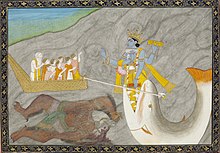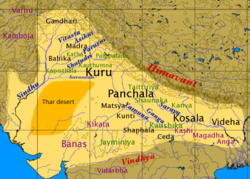Meena
This article has multiple issues. Please help improve it or discuss these issues on the talk page. (Learn how and when to remove these messages)
No issues specified. Please specify issues, or remove this template. |
| Meena | |
|---|---|
| Languages | Hindi, Mewari, Marwari, Dhundari, Harauti, Wagdi, Malvi, Garhwali, Bhili etc.[1] |
| Subdivisions | Meo, Rajput or pardeshi community in Maharashtra. |
The Meena caste—whose name is also transliterated as Meenanda or Mina—is found mainly in the Rajasthan region of India. Their name is derived from Meen, the Sanskrit word for fish, and they claim descent from the Matsya avatar, or fish incarnation, of Vishnu.
Scholars have disagreed as to whether the Meenas are an indigenous tribe, or whether they migrated to the region from Central Asia. According to Britannica, "the Minas are possibly of inner Asiatic origin, and tradition suggests that they migrated to India in the 7th century ". They once ruled the Matsya Kingdom but their social significance diminished thereafter. This change began with their assimilation with Scythian people and reached a low point when the British government declared them to be a criminal tribe. This action was taken to support their alliance with Rajput kingdom then in Rajasthan, and Meenas were still in war with Rajputs, carrying out guerrilla attacks to retain their lost kingdoms.
Meenas celebrate Meenesh Jayanti in the name of Vishnu on 3 Tithi of Chaitra Shukal paksha according to the Hindu calendar. The main reference of this belief is based on the scripture of the Matsya Purana.[2]
History
Nandini Sinha Kapur, a historian who has studied early India, notes that the oral traditions of the Meenas were developed from the early 19th century AD in an attempt to reconstruct their identity. She says of this process, which continued throughout the 20th century, that "The Minas try to furnish themselves a respectable present by giving themselves a glorious past". In common with the people of countries such as Finland and Scotland, the Meenas found it necessary to invent tradition through oral accounts, one of the primary uses of which is recognised by both historians and sociologists as being "social protest against injustices, exploitation and oppression, a raison d'être that helps to retrieve the image of a community." Kapur notes that the Meenas not merely lack a recorded history of their own but also have been depicted in a negative manner both by medieval Persian accounts and records of the colonial period. From medieval times through to the British Raj, references to the Meenas describe them as violent, plundering criminals and an anti-social ethnic tribal group.[3]
Vedic period

Their name is derived from Meen, the Sanskrit word for fish, and the Meenas claim descent from the Matsya avatar, or fish incarnation, of Vishnu.[2][4] The Rig Veda includes the Meenas among the pure Kshatriya tribes of ancient India.[5]

A Meena dynasty ruled Rajasthan in ancient times and their emblem was a fish, similar to that used by the Pandyan kingdom of the south.[6][page needed][7] It lay to south of the kingdom of Kurus and west of the Yamuna which separated it from the kingdom of Panchalas. It roughly corresponded to former state of Jaipur in Rajasthan, and included the whole of Alwar with portions of Bharatpur.[8] The capital of Matsya was at Viratanagar (modern Bairat) which is said to have been named after its founder, king Virata. Meenas are brothers and kinsmen of Virata, the ruler of Virat Nagar. They ruled this area(near to Virat Nagar) till 11th century.[9][10]
The most famous Matsya ruler was Virata, the ally of the Pandavas.[11] Upaplavya was a city in the Meena Kingdom ruled by king Virata. It was the city where the Pandavas camped and planned their strategy for the Kurukshetra War.[12] Kichaka Kingdom was a part of the Matsya kingdom ruled by the Meenas rulers. Kichaka Kingdom was allied to King Virata. The Kichaka king, known by the name Kichaka was the commander-in-chief of the Matsya-army under king Virata.[10]
The Meena Kingdom was known as “Matsya” as each of these Janapadas was named after the Kshatriya tribe (or the Kshatriya Jana) who had settled therein.[13] Around 300 BC, the Meena kingdom succumbed to the rising Mauryan empire.[14][15] The present day Meenas of Rajasthan still follow Vedic culture: they mainly worship Shiva, Hanuman and Krishna as well as the Devas.[16]

Medieval period

Kyaranagar in Thanaghazi was an important city of Meenas, whose ruler was Rao Mokalsingh Meena at the time of Akbar’s reign. The armies of Mughals and Kachwaha Rajputs plundered Kyaranagar and in its place founded Mohamadabad. they are very brave and follow all ancient tradition.[17]
British colonial period

The system of colonial administration known as the British Raj came into existence in 1858, following the Indian Rebellion of 1857 which caused the government of Britain to decide that leaving colonial administration in the hands of the East India Company was a recipe for further discontent. In an attempt to create an orderly administration through a better understanding of the populace, the Raj authorities instituted various measures of classifying the people of India.[18] One such measure was the Criminal Tribes Act of 1871, under the provisions of which the Meenas were placed. The community remained stigmatised for many years, notably by influential officials of the Raj such as Herbert Hope Risley and Denzil Ibbetson, and were sometimes categorised as animists and as a hill tribe similar to the Bhils.[19] The Meenas remained an officially-designated criminal tribe until 1952, three years after the Act had been repealed. Mark Brown has examined the impact and issues of the Meena community during British rule, and the change in their status from being a higher social group to a criminal tribe. He also mentioned the division in the Meenas as zamindar group and chowkidar Meenas.[20]
Recent history
Meenas have better rights for women in many respects compared to many other Hindu castes.[16] Hindu law as codified through acts passed between 1955 and 1956 were based on inegalitarian Victorian English patters of marriage and inheritance and on the customary practices of some the dominant communities in North-West India, among whom women's right have been seriously coded. The practices of the Nairs in Kerala, Meitei in Mainipur, Meenas in Rajasthan and Jains, which provide better rights to women in many respects, were presumed to be non-existent or non-Indian. Thus the Hindu codified law is in many ways a step backward for some communities.[16][21][full citation needed]
The Meenas of the Karauli, Sawai Madhopur, Jaipur, Gangapur area are the most important cultivators for the last four hundred years. They expelled the Dhangars and Lodhis from a number of villages they occupied 500 years ago, and have retained their possession until now. In Karauli(Rajasthan), the Meenas, Gurjars and Jats smoke together. They live in complete harmony.[6][page needed]
Meena of Haryana
In Haryana, the Meena are found mainly in the districts of Gurgaon district, Mahenderagarh and Hissar. Unlike the Rajasthan Meena, the Haryana Meena have not been granted Scheduled Tribe status. They are divided into a number of gotras, the main ones being the Boya, Sihra, Jarwaal, Jepha, Papati, Morjal, Kawat, Gomalhada, Khangash, Jakhiwal, Nagori and Tajee. Each of these clans are of equal status, and intermarry. The Haryana Meena are largely a community of peasant farmers. They now speak Haryanvi, but most also understand Hindi.[22]
Meena of Uttar Pradesh
In [uttar pradesh] the Meena are found mainly in the districts of [Meerut district in tehsil sardhana]villages`Maharmati meena,Begmabad,choti mandyi,Tanda. They are divided into a number of gotras, the main ones being the Kakroda,Devarwal,Mewal,Singal,Bagdi,Jonewal,Naimeena,madhai,mehar etc.the up meena are largely a community of peasant farmers.[citation needed]
See also
- Bhil Meena
- Rajasthani people
- Rigvedic tribes
- Dhundhar
- Matsya Rajya
- Minhas
- Lothoo Nitharwal
- Nadar (caste)
References
- ^ See also Mina (India) at Ethnologue (17th ed., 2013)

- ^ a b Kapur, Nandini Sinha (May 2008). "Reconstructing Identities and Situating Themselves in History : A Note on the Meenas of Jaipur Region". d'échange bilatéral franco-indien durant le mois de mai 2008.
{{cite journal}}: Cite journal requires|journal=(help)CS1 maint: year (link) - ^ Kapur, Nandini Sinha (2007). "The Minas: Seeking a Place in History". In Bel, Bernard (ed.). The Social and the Symbolic. Sage. pp. 129–131. ISBN 9780761934462.
- ^ Sharma, Mathura Lal (1971). "Rajasthan". Publications Division, Ministry of Information and Broadcasting, Govt. of India.: 191.
{{cite journal}}: Cite journal requires|journal=(help) - ^ The Rigveda: A Historical Analysis, Aditya Prakashan, New Delhi 2000
- ^ a b Rizvi, S. H. M. (1987). Mina, The Ruling Tribe of Rajast.han (Socio-biological Appraisal). Delhi: B.R. Pub. Corp.
- ^ The Modern review, Volume 84, Ramananda Chatterjee, Prabasi Press Private, Ltd., 1948 - History.
- ^ Sukh Sampati Raj Bhandari: Bharat ke deshi rajya, Jaypur rajya ka Itihas, page 3
- ^ Kanakasabhai, V. (1989). The Tamils Eighteen Hundred Years Ago. Asian Educational Services. ISBN 81-206-0150-5.
- ^ a b Mahabharata of Krishna Dwaipayana Vyasa, translated to English by Kisari Mohan Ganguli.
- ^ The Sacred books of the Hindus, Volume 27, Part 1, By Baman Das Basu,p99.
- ^ C. Rajagopalachari, Mahābhārata, Bharatiya Vidya Bhavan. 1994
- ^ India as Known to Panini: A Study of the Cultural Material in the Ashṭādhyāyī, 1963, p 427, Vasudeva Sharana Agrawala — India; India in the Time of Patañjali, 1968, p 68, Dr B. N. Puri — India; Socio-economic and Political History of Eastern India, 1977, p 9, Y. K Mishra — Bihar (India); Tribes of Ancient India, 1977, p 18, Mamata Choudhury — Ethnology; Tribal Coins of Ancient India, 2007, p xxiv, Devendra Handa — Coins, Indic - 2007; The Journal of the Numismatic Society of India, 1972, p 221, Numismatic Society of India — Numismatics .
- ^ Kulke, Hermann; Rothermund, Dietmar (2004), A History of India, 4th edition. Routledge, Pp. xii, 448, ISBN 0-415-32920-5.
- ^ Thapar, Romila (1990), A History of India, Volume 1, New Delhi and London: Penguin Books. Pp. 384, ISBN 0-14-013835-8.
- ^ a b c Kishwar, Madhu (1994). ‘Codified Hindu Law. Myth and Reality ‘,. Economics and political weekly,.
{{cite book}}: CS1 maint: extra punctuation (link) - ^ Rajasthan [district Gazetteers]: Alwar,Printed at Govt. Central Press, 1968 - History.
{{cite book}}: Missing or empty|title=(help)CS1 maint: multiple names: authors list (link) CS1 maint: numeric names: authors list (link) - ^ Naithani, Sadhana (2006). In quest of Indian folktales: Pandit Ram Gharib Chaube and William Crooke. Indiana University Press. ISBN 978-0-253-34544-8. Retrieved 2013-04-15.
- ^ Kapur, Nandini Sinha (2007). "The Minas: Seeking a Place in History". In Bel, Bernard (ed.). The Social and the Symbolic. Sage. p. 131. ISBN 9780761934462.
- ^ Brown, Mark (2004). "Crime, Liberalism and Empire: Governing the Mina Tribe of Northern India". Social and Legal Studies. 13 (2): 191–218. doi:10.1177/0964663904042551.
- ^
Agrwal, Bina (1989). "Rural Women, Poverty and Natural Resources". Economics and Political Weekly.
{{cite journal}}: Cite journal requires|journal=(help) - ^ People of India Hayana Volume XXIII edited by M.L Sharma and A.K Bhatia pages 342 to 354 Manohar
Further reading
- Adak, Dipak Kumar. Demography and health profile of the tribals: a study of M.P. Anmol Publications.
